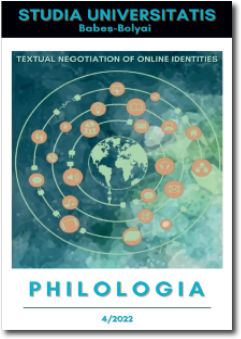TRANSLATION SOLUTIONS FOR DEALING WITH AMBIGUITY IN “ALICE’S ADVENTURES IN WONDERLAND”
DOI:
https://doi.org/10.24193/subbphilo.2022.4.21Keywords:
Carrollian humor; ambiguity; translation solutions; disambiguation techniques; textual challengesAbstract
Translation solutions for dealing with ambiguity in Alice’s Adventures in Wonderland. This paper shows how different types of ambiguity embedded in the matrix of Lewis Carroll’s Alice’s Adventures in Wonderland (the 1993 edition) are dealt with in two prestigious Romanian translations – Frida Papadache’s Peripeţiile Alisei în Ţara Minunilor (1976) and Antoaneta Ralian’s Alice în Ţara Minunilor (2007) – as a tribute to the international appeal of Alice. My focal aim is to present a comparative analysis of the methods employed in translating Carroll’s equivocal lexical items, which make it increasingly difficult to match grammatical categories with function. This paper also aims at describing disambiguation techniques applied primarily in determining if the two translators managed to reinforce the original textual leeway at their disposal in the pure spirit of Carroll. My analysis relies heavily on Dirk Delabastita’s translation strategies as precautionary measures to cope with Carroll’s specialized type of literary discourse. The findings submitted by this paper are consistent with the idea that translating Carroll’s craft unavoidably entails a partial loss of meaning, brought about by the yawning gap between the intended message and interpretation, which can result in either overtranslation or undertranslation. The extensive use of double-entendre in the source-text cannot be recoded entirely in the target language, despite the translators’ excellent command of English.
Article history: Received 8 June 2022; Revised 21 November 2022; Accepted 25 November 2022; Available online 20 December 2022; Available print 30 December 2022.
REZUMAT. Soluții de traducere a ambiguității din Alice’s Adventures in Wonderland. Acest articol arată că modul în care diferitele tipuri de ambiguitate încadrate în matricea textuală a lui Lewis Carroll în Alice’s Adventures in Wonderland (ediția din 1993) sunt tratate în două traduceri românești de vază – Peripețiile Alisei în Țara Minunilor (1976), tradusă de Frida Papadache, și Alice în Țara Minunilor (2007), tradusă de Antoaneta Ralian – aduce un omagiu notorietății internaționale de care se bucură Alice. Scopul acestui articol este să prezinte o analiză comparativă a metodelor alese în traducerea termenilor echivoci care împiedică formarea corespondenței formă-funcție. Un alt obiectiv rezidă în descrierea tehnicilor de dezambiguizare aplicate pentru a determina în ce măsură traducătoarele au împrumutat, în manieră carrolliană, atmosfera lingvistică a textului-sursă, având în vedere strategiile de traducere propuse de Dirk Delabastita ca măsuri de precauție în explorarea discursului specializat al lui Carroll. Constatările acestei lucrări arată că încercarea de a-l traduce pe Carroll inevitabil implică omisiuni lexicale cauzate de distanța mare dintre mesajul scriptic livrat de autor și interpretarea ulterioară. Aceasta duce, în cele din urmă, fie la supratraducere, fie la subtraducere. Folosirea deasă a calamburului în textul-sursă nu poate fi oglindită integral în textul-țintă, în ciuda nivelului excelent de limbă engleză deținut de cele două traducătoare.
Termeni-cheie: umor carrollian; ambiguitate; soluții de traducere; tehnici de dezambiguizare; provocări textuale
References
Carroll, Lewis. 1993. Alice in Wonderland and Through the Looking Glass. Great Britain: Wordsworth Classics.
—. 2007. Alice în Țara Minunilor. București: Editura Univers.
—. 1976. Peripețiile Alisei în Țara Minunilor. București: Editura Ion Creangă.
Crystal, David. 1998. “Carrolludicity.” The Lewis Carroll Phenomenon. Cardiff: University of Wales. 1-12.
Davis, Kathleen. 1997. “Signature in Translation.” In Traductio. Essays on Punning and Translation, by Dirk Delabastita, 23-43. Manchester: St.Jerome Publishing.
Delabastita, Dirk. 1997. “Introduction.” In Traductio. Essays on punning and translation, by Dirk Delabastita, 1-22. Manchester: St. Jerome Publishing.
Delabastita, Dirk. 1987. “Translating Puns. Possibilities and Restraints.” New Comparison 143-159.
Harley, Trevor A. 2014. The Psychology of Language. From Data to Theory. 4th. New York.
Hirst, Graeme. 1987. Semantic Interpretation and the Resolution of Ambiguity. London: Cambridge University Press.
Hurford, James R., and Brendan Heasley. 1983. Semantics: a coursebook. Great Britain: Cambridge University Press.
Kess, Joseph F., and Yoshihiro Nishimitsu. 1989. Linguistic Ambiguity in Natural Language: English and Japanese. Tokyo: Kuroshio Shuppan.
Lyons, John. 1978. Semantics. Cambridge: Cambridge University Press.
Oaks, Dallin D. 2010. Structural Ambiguity in English. An Applied Grammatical Inventory. London: Continuum International Publishing Group.
Rickard, Peter. 1975. “Alice in France or Can Lewis Carroll Be Translated?” Comparative Literature Studies, March: 45-66.
Rozakis, Laurie E. 2003. The Complete Idiot's Guide to Grammar and Style. Indianopolis: Alpha.
Sutherland, Robert D. 1970. Language and Lewis Carroll. The Hague & Paris: Mouton.
Vetrov, Viatcheslav. 2021. The Linguistic Picture of the World. Alice's Adventures in Many Language. Baden-Baden: Ergon Verlag.
Wasow, Thomas. 2002. Postverbal Behaviour. Stanford, California: CSLI.
Weaver, Warren. 1964. Alice in Many Tongues. The Translations of Alice in Wonderland. Madison: The University of Wisconsin Press.
Downloads
Published
How to Cite
Issue
Section
License
Copyright (c) 2022 Studia Universitatis Babeș-Bolyai Philologia

This work is licensed under a Creative Commons Attribution-NonCommercial-NoDerivatives 4.0 International License.





 ©Studia Universitatis Babeş-Bolyai Philologia. Published by Babeș-Bolyai University.
©Studia Universitatis Babeş-Bolyai Philologia. Published by Babeș-Bolyai University.